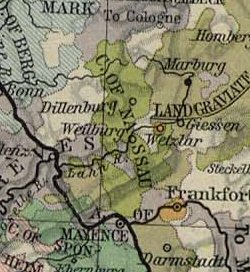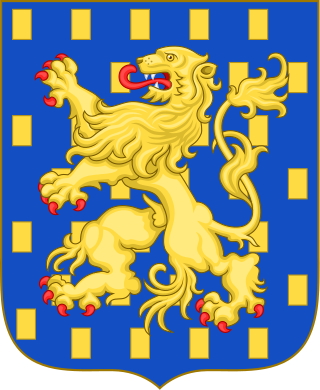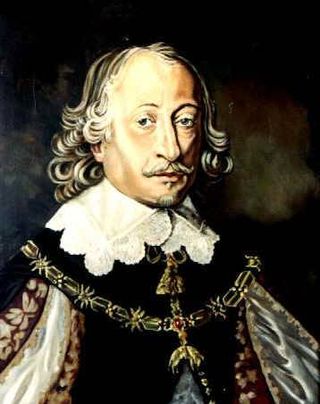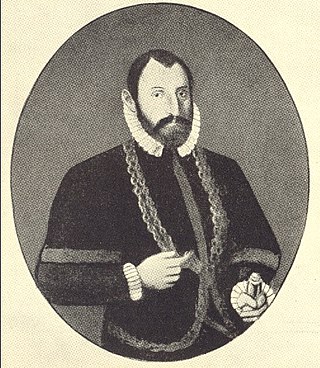Related Research Articles

The County of Nassau was a German state within the Holy Roman Empire and later part of the German Confederation. Its ruling dynasty, the male line of which is now extinct, was the House of Nassau.

William I of Nassau-Siegen, nicknamed the Elder or the Rich, was Count of Nassau-Siegen and of half Diez from 1516. He descended from the Ottonian Line of the House of Nassau.

Count John VI of Nassau-Dillenburg was the second son of William the Rich and the younger brother of William the Silent. He has a special place in the history of the Netherlands because he is the male-line forefather of the House of Orange.

The House of Nassau is a diversified aristocratic dynasty in Europe. It is named after the lordship associated with Nassau Castle, located in present-day Nassau, Rhineland-Palatinate, Germany. With the fall of the Hohenstaufen in the first half of the 13th century royal power within Franconia evaporated and the former stem duchy fragmented into separate independent states. Nassau emerged as one of those independent states as part of the Holy Roman Empire. The lords of Nassau were originally titled "Count of Nassau", subject only to the Emperor, and then elevated to the princely class as "Princely Counts". Early on they divided into two main branches: the elder (Walramian) branch, that gave rise to the German king Adolf, and the younger (Ottonian) branch, that gave rise to the Princes of Orange and the monarchs of the Netherlands.
Otto I of Nassau, German: Otto I. von Nassau was Count of Nassau and is the ancestor of the Ottonian branch of the House of Nassau.

Juliana, Countess of Stolberg-Wernigerode was the mother of William the Silent, the leader of the successful Dutch Revolt against the Spanish in the 16th century.

John VIII, Count of Nassau-Siegen was a German nobleman and militarist of the 17th century.

Count John IV of Nassau-Siegen, German: Johann IV. Graf von Nassau-Siegen, official titles: Graf zu Nassau, Vianden und Diez, Herr zu Breda, was since 1442 Count of Nassau-Siegen, of Vianden and of half Diez, and Lord of Breda and of the Lek. He descended from the Ottonian Line of the House of Nassau.

Count Otto II of Nassau-Siegen, German: Otto II. Graf von Nassau-Siegen, was since 1343 Count of Nassau-Siegen. He descended from the Ottonian Line of the House of Nassau.

Henry I of Nassau-Siegen, German: Heinrich I. von Nassau-Siegen was Count of Nassau-Siegen, a part of the County of Nassau, and ancestor of the House of Nassau-Siegen. He comes from the Ottonian branch of the House of Nassau.

Philip IV of Nassau-Weilburg, also known as Philip III of Nassau-Saarbrücken was Count of Nassau-Weilburg from 1559 until his death and since 1574 also Count of Nassau-Saarbrücken. Both possessions belonged to the Walram line of the House of Nassau. In Weilburg, he was the fourth count named Philip, but only the third in Saarbrücken, because his father, Philip III of Nassau-Weilburg never held Nassau-Saarbrücken.

Count Philip IV of Waldeck was Count of Waldeck-Wildungen from 1513 to 1574. In 1526, he and his uncle Philip III of Waldeck-Eisenberg led the Lutheran Reformation in the county of Waldeck.

John Louis of Nassau-Hadamar, and also known in German as Johann Ludwig, was a German nobleman and member of the House of Nassau who is best known for his role as an aide to the head of the imperial delegation for the Peace of Westphalia, Count Maximilian von Trautmansdorff.
Count Louis I of Nassau-Weilburg was a son of Count John III of Nassau-Weilburg and his wife, Elisabeth of Hesse. In 1492, Louis I succeeded his grandfather Philip II as Count of Nassau-Weilburg, because his father had already died in 1480.

Count George of Nassau-Beilstein, later also Count of Nassau-Dillenburg, was the third son of Count John VI "the Elder" of Nassau-Dillenburg (1536–1606) from his first marriage with Landgravine Elisabeth of Leuchtenberg.
Henry II, Count of Nassau-Beilstein was the eldest son of Henry I and his wife, Imagina of Westerburg. He succeeded his father in 1388 as Count of Nassau-Beilstein and ruled jointly with his younger brother Reinhard.
Henry I, Count of Nassau-Beilstein (1307-1388) was a son of Henry I of Nassau-Siegen and his wife, Adelaide of Heinsberg-Blankenberg. His parents had initially destined him for an ecclesiastical career. However, he later married Meyna of Westerburg and after his father's death became the first count of Nassau-Beilstein.

Louis I, Count of Sayn-Wittgenstein, nicknamed "the Elder", formally "Louis I of Sayn, Count at Wittgenstein" ruled the County of Wittgenstein, on the upper reaches of the rivers Lahn and Eder, from 1558 until his death. He converted his county to Calvinism and was an influential politician in the service to the Electoral Palatinate.
John II, Count of Nassau-Beilstein was a son of Count Henry IV and his wife, Eva of Sayn. His father was son of John I which in turn was son of Henry II, Count of Nassau-Beilstein.
John, Count of Nassau-Dillenburg was the third son of Count Otto I of Nassau and his wife Agnes, daughter of Count Emich IV of Leiningen-Landeck. John was a first cousin of King Adolf of the Romans.
References
- ↑ Anderson, James (1736). Royal Genealogies: Or the Genealogical Tables of Emperors, Kings and Princes from Adam to These Times. pp. 542–543.